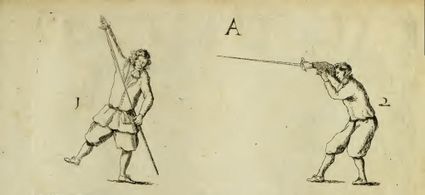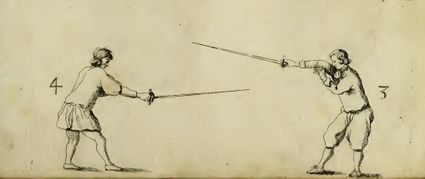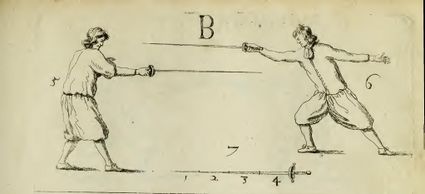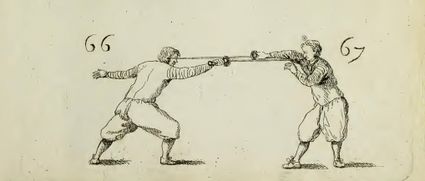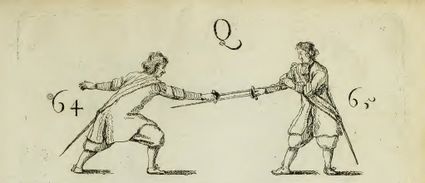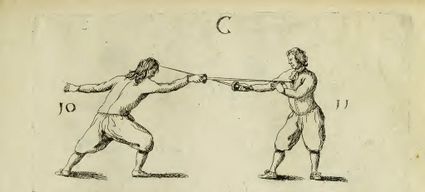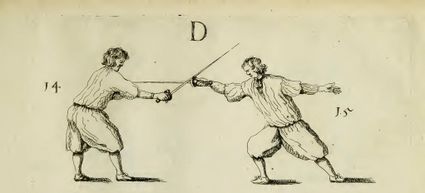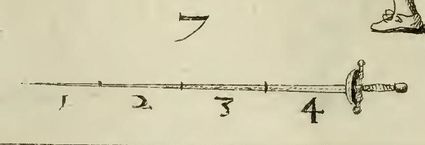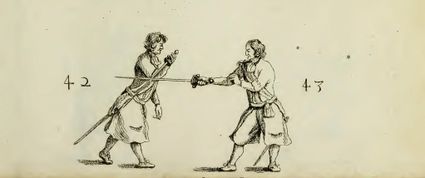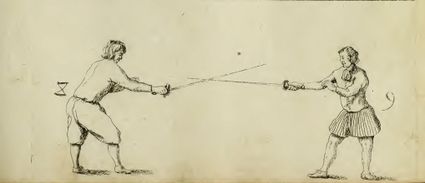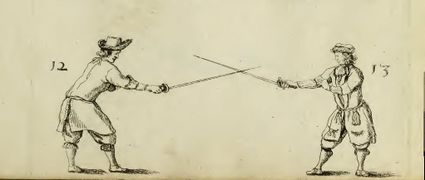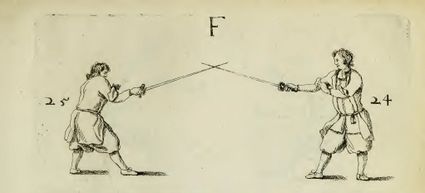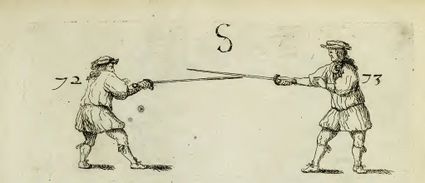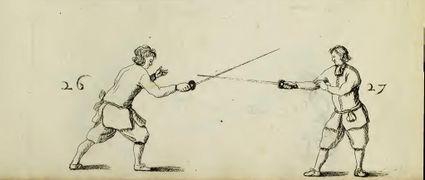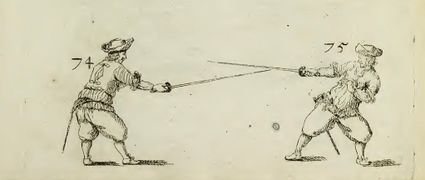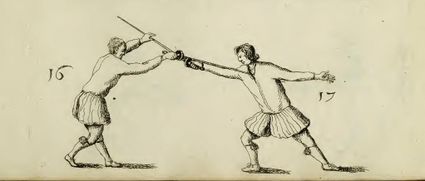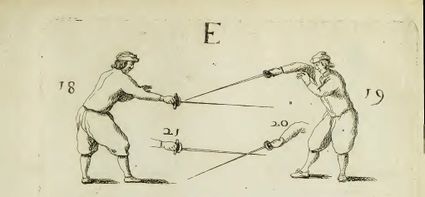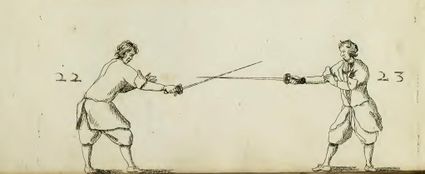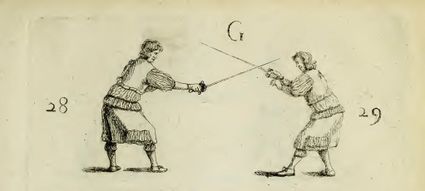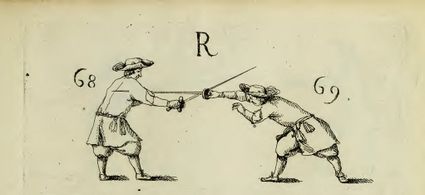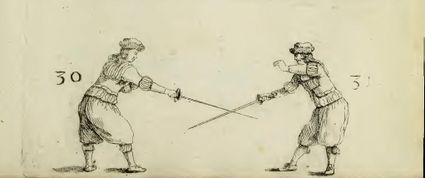|
|
You are not currently logged in. Are you accessing the unsecure (http) portal? Click here to switch to the secure portal. |
Johannes Georgius Bruchius
| Johannes Georgius Bruchius | |
|---|---|
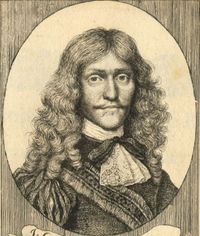 | |
| Born | ca. 1630 Zweibrücken, Germany |
| Died | 1717-1718 Utrecht, Netherlands |
| Occupation | Fencing master |
| Influences | |
| Influenced | Johann Andreas Schmidt |
| Genres | Fencing manual |
| Language | Dutch |
| Notable work(s) | Grondige Beschryvinge van de Edele ende Ridderlijcke Scherm- ofte Wapen-Konste (1671) |
Johannes Georgius Bruchius was a 17th century German fencing master. He was born in Zweibrücken, Germany in ca. 1630, and by 1653 he was working as a fencing master in Heidelberg. In 1655, Bruchius transplanted to Utrecht, Netherlands, where on 6 March the city council authorized him to teach public classes; the official record notes that he was requested by a number of German nobles. In 1660, he accepted a position as fencing master at the prestigious Universiteit Leiden, where he taught for at least eleven years. Some time between 1671 and 1676, Bruchius opened a new school in Amsterdam where his students included Johann Andreas Schmidt, a fellow German who would himself go on to be a fencing master and author.[1]
In 1671, Bruchius published an extensive fencing manual entitled Grondige Beschryvinge van de Edele ende Ridderlijcke Scherm- ofte Wapen-Konste ("Thorough Description of the Noble and Knightly Fencing- or Weapon-Art"). It was published in Leiden by Abraham Verhoef, and treated the use of the single rapier after the German manner, which was itself heavily influenced by the teachings of the Italian master Salvator Fabris.[1]
In 1680, Bruchius returned to Utrecht and his activities thereafter are unknown (though it's likely that he continued teaching fencing). He appears to have died in Utrecht between 1717 and 1718.[1]
Contents
- 1 Treatise
- 1.1 Preface and Dedication
- 1.2 Rapier
- 1.2.1 The Basics of Rapier
- 1.2.2 Lessen 1-16: Eerst, Op wat manier, ofte gestalte, door verscheyde beweginge, de Quarta moet werden gestooten
- 1.2.3 Lessen 17-25: Volgt nu, hoe de Lange-Stockada van buyten over den Rechten-arm moeten gedaen worden, op verscheyde manieren.
- 1.2.4 Lessen 26-43: Volght nu, hoe men de Finta Practicéren sal, op veelderhande Manier, Enckel ende Dubbelt
- 1.2.5 Les 44: Volght van de halve Passaden van binnen
- 1.2.6 Lessen 45-51: Volght nu van de heele Passade, hoe dat men van binnen het Lichaem, onder den Lemmer, zal wegh passeren
- 1.2.7 Lessen 52-62: Volght nu, hoe datmen van buyten, onder sijn Adversariums Lemmer, sal wegh passeren
- 1.2.8 Lessen 63-64: Volght, hoe ghy u Parthije, over den rechten arm, passeren sult
- 1.2.9 Lessen 65-66: Volght, hoe gy uwen Adversarium het Cavéren verhinderen sult, ofte wanner hy hem niet wil strengéren laten, hoe ghy u dragen sult
- 1.2.10 Lessen 67-74: Volght, hoe ghy u selven van het strengéren verlossen sult, alwaer die Graduationes insonderheyt te nut komen; die een yeder van sijn Leer-meester sal konnen geinformeert werden, om dat het sulcke subtijle beweginge is, die niet wel met Figueren konnen uytgebeeldt werden
- 1.2.11 Lessen 75-82: Volgen nu eenige Lessen, waer in ghy de Demi-Stockada gebruycken kondt
- 1.2.12 Lessen 83-85: Volght nu, hoe ghy uwen Adversarium sijn Rapier dwingen ende verswavken sult
- 1.2.13 Lessen 86-91: Wanneer uwen Adversarium u over uwen rechten-arm wilde stooten, hoe ghy u dragen sult
- 1.2.14 Lessen 92-95: Volght, wanneer Adversarius u van binnen met de Quarta blesseren wilde, hoe ghy u daer tegen defendéren sult
- 1.2.15 Lessen 96-98: Volght, hoe ghy de Ligéringe wel maken sult
- 1.2.16 Lessen 99-103: Volght nu, hoe ghy met de Punt ontrent uwes Adversariums sijn Gevest gaen sult
- 1.2.17 Lessen 104-107: Volgen nu eenige Lessen, hoe ghy uwen Lemmer van buyten sult sacken laten
- 1.2.18 Lessen 108-112: Volght nu hoe ghy uwen Lemmer van binnen sult sacken laten
- 1.2.19 Lessen 113-128: Volght nu hoe ghy de Quarta Voltéren sult
- 1.2.20 Lessen 129-131: Volght nu, hoe ghy uwen Adversarium dat Voltéren beletten sult
- 1.2.21 Lessen 132-136: Volght, hoe ghy uwen Adversarium het Passéren beletten sult
- 1.2.22 Lessen 137-138: Volght, hoe ghy uwen Adversarium het Mutéren beletten sult
- 1.2.23 Lessen 139-149: Volght, hoe ghy uwe slincker-handt met avantagie tot uwen voor-deel gebruycken sult
- 1.2.24 Lessen 150-152: Volght nu, wanneer uwen Adversarium sijnen Lemmer achter-waerts treckt, wanneer hy stooten wil, hoe gy u selven dragen sult
- 1.2.25 Lessen 153-157: Volght, hoe ghy de Chymata maken sult
- 1.2.26 Lessen 158-167: Volght, hoe ghy de overheffingen van binnen ende van buyten gebruycken sult
- 1.2.27 Lessen 168-169: Volght nu, hoe ghy uwen Adversarium het overheffen beletten sult
- 1.2.28 Lessen 170-171: Volght, hoe ghy met de QUarta over uwen Adversarium sijnen Rechten-arm stooten sult
- 1.2.29 Lessen 172-173: Volght, hoe ghy uwen Adversarium over sijnen Rechten-arm Voltéren sult
- 1.2.30 Lessen 174-176: Volght nu, hoe ghy uwen Adversarius sijnen Lemmer Rumpéren sult
- 1.2.31 Lessen 177-184: Volght nu, wanneer ghy u in de Hooge Secunda herstelt hebt, wat ghy voor Lessen gebruycken sult
- 1.2.32 Lessen 185-188: Volght, hoe ghy de Riversa binnen ende buyten stooten sult
- 1.2.33 Lessen 189-200: Volght nu, soo u Contra-Parthije in de Hooge Secunda leyde, hoe ghy u selver daer tegen dragen sult
- 1.2.34 Lessen 201-203: Volght, hoe ghy met u slincker-voet voor-staen sult
- 1.2.35 Lessen 204-205: Volght, hoe ghy de verdraeyinge van den Lemmer tot u voor-deel sult gebruycken, sonder van den Lemmer te gaen
- 1.2.36 Lessen 206-210: Volght nu van de Des-armationes, hoe ghy uwen Adversarium sijn Rapier uyt sijn Handt ontweldigen sult
- 1.2.37 Extraordinari Stucken
- 1.3 Copyright and License Summary
- 2 Additional Resources
- 3 References
Treatise
Illustrations |
Dutch Transcription |
Modern Dutch Translation |
Modern English Translation |
|---|---|---|---|
GRONDIGE BESCHRYVINGE Van de Edele ende Ridderlijcke SCHERM- ofte WAPEN-KONSTE Noyt diergelijcke in dese Nederduytste Tale in den Druck uytgegaen.
Johannes Georgius Bruchius, Scherm-ofte Vecht-Meester der wijt-vermaerde Academie tot Leyden.
voor Daniel van den Dalen, Boeckverkoper op de Nieuwendijk, 1676. |
|||
Aen de Wel-Edele, Achtbare, seer Voorsienige Heeren Mijn Heeren De CURATEUREN Van de Hoogh-Beroemde ende Wijt-vermaerde Universiteyt binnen Leyden. d'Heer FREDERICUS van DORP, Heeren van Maasdam, Lit van de Ridderschap van Hollant, Dijck-graaf van Rhijnlandt; eertijts Ambassadeur by de Doorluchtigste ende Grootmachtigste Koningen van Poolen en Sweden, &c. d'Heer JOHANNES van THILT, J.C. Burgemeester der Stadt Haerlem, Heemraat van Rhijnlant, &c. d'Heer CORNELIS de WIT, Ruwaard van Putten, Bailjuw van Beyerlandt, Burgemeester van Dordrecht, Gecommitteerde Raat van Hollant, &c. |
|||
Gelijck mede aen de Heeren Burgermeesters der Stadt Leyden d'Heer en Mr. JOHAN MEERMAN, J.C. eertijts Ambassadeur by den Doorluchtigsten en Grootmachtigsten Koninck van Engelant, Schotlant, ende Yerlant, &c. d'Heer en Mr. PAULUS van SWANENBURGH, J.C. d'Heer JACOB Maas. d'Heer DANIEL van ALPHEN Benevens den Achtbaren Wijsen Heer, d'Heer en Mr. PIETER BURGERSDYCK, J.C. Pensionaris der Stadt Leyden, ende Secretaris der boven-gemelte Academie. MYN HEEREN: Ick TWijffel niet, of het sal u H.E. seer wonder ende vreemt voor-komen, dat sulck een Man als ick, die niet anders gewoon ben als de Wapenen, ende 'tgene daer mede over-eenkomt, te handelen, my soo verre hebben laten vervoeren, dat ick mijn Penne hebbe durven op het Papier setten, om de Werelt met een |
|||
Boeck te verrijcken. Maer soo u H.E. de stoffe, die daer in verhandelt wort, aensiet, houde ick my verseeckert dat die verwondering, indien niet in 't geheel, ten minsten eenighsins verstuyven sal. Ende seecker, ick soude dit Werck niet wel hebben durven ondernemen, soo ick niet de Voetstappen van deftige Mannen voor my hadde. Gelijck onder anderen den Hoogh-beroemden Salvatoris Fabri, die in de Italiaense Tale hier van geschreven heeft, als mede den Hoog-geachten Gerardus Thibault, de welcke al voor 43 Jaren yets ontrent dese saeck in de Françoysche Tale heeft aen den dagh gebracht; hoewel dat Werck in sijn selven Loff-waerdig is: soo is nochtans die manier van Circkel-vechten, die hy daer in wijtloopigh beschrijft, in dese Dagen buyten gebruyck geraeckt, soo van wegen de moeyelijckhey die daer aen vast is, als oock om dat nu niemant soo veel tijdts (als wel voor dese de Oude Lief-hebbers gedaen hebben) daer aan te kost leggen wil, 'twelck te beklagen is: 'tls nu soo verre met dese Konste gekomen, datmen geen onderscheyt maeckt tusschen goede ofte quade onderrechtinge, die aen de Jonge Manschap |
|||
gedaen wort, die, om datse in noch onervaren zijn, sich seer licht laten innemen van sulcke, dien deze Konst meer in de mondt geslagen is, als wel door ervarentheyt verkregen hebben, het welcke heden ten Dage, niet dan al te gemeen is. Daer zijn ny bykans 17. Jaren door-geloopen, dat ick dese Landen met mijn Konste hebbe by gewoont, want daer ick van het Jaer 1653. Heydelbergh bedient hadde, wierdt ick in 't Jaer 1655. van daer na Uytrecht geroepen: alwaer ick met alle lof (volgens mijn Attestatie) mijn Konst tot het Jaer 1660. geoeffent hebbe; op welcke tijdt ick, op het aenhouden van veele Liefhebbers, Uytrecht verlaten hebbende, op dese wijt-beroemde Academie ben gekomen. Maer dewijl ick mijn oogh-wit tot noch toen niet hebbe konnen bereycken, hebbe ick dit Werck in het licht gebracht, om my daer door in u H.E. geheugenisse te brengen; ende oock met een, op dat dese mijn Wapen-oeffeninge, op het sterck aenhouden, ende versoeck van eenige edelmoedige Zielen, beschreven, tot dienst van veele strecken mocht: door welcke ick my |
|||
oock hebbe laten bewegen, om alles met geen kleyne kosten, na het leven te laten af-teyckenen, ende in het koper te doen brengen, tot meer gemack ende proffijt van de Leerlingen. Dewijl ick dan dese mijnen arbeyt, moeyte ende kosten tot het algemeene-best van de Nederduytsche Natie, op my genomen heb, soo konde ick niemant beter uyt kiesen om dit Werck op te offeren, als u H.E. als wel verseeckert zijnde, dat ghy als machtige Bescherm-Heeren my voor den Zoïlus genoeghsaem sult konnen beschermen. Soo versoeck ick dan in alle ootmoedigheyt, dat u H.E. dit weynigh, eenvoudigh, doch grondigh Werck, gelieft aen te nemen, ende my in u H.E. goedertierentheyt in te laten. Hier mede beveel ick u H.E. in de bewaringe des Aller-machtighste Bescherm-Heers, ende my in u H.E. goede gunst ende genade. Gegeven in Leyden den 2. Julij 1671. U H.E. Heeren Heeren onderdanghstenende ootmoedighste Dienaer JOHANNES GEORGIUS BRUCHIUS, Scherm-ofte Vecht-Meester in Leyden. |
|||
AEN DEN LESER Goet-gunstige Leser: Denckt niet, dat ick oyt soude voor-genomen hebben dit Boeck aen de wereldt mede te deelen, dewijl'er al eenige zijn, die voor my van dese materie, soo wel in 't Hooghduytsch, Italiaens, als in 't Franch seer konstelijck ende wijt-loopigh geschreven hebben; indien ick niet (by een algemeen gebreck van die noodige ende vermaerde Schriften, die nu naeuwlijcks meer te vinden zijn) van een groot getal Liefhebbers ende verscheyde Staets-luyden van dit Landt, door haer geduyrigh aenhouden, gedwongen ende gepranght was geweest, om dit werck oock in 't Neerlantsch uyt te geven. Derhalven hebbe ick, om dese hare begeerte te voldoen, die Ridderlijcke ende overdeftige Konst van 't Schermen in dese weynige Bladeren, na mijn uyterste vermogen, seer beknopt ende zonnen-klaer voor-gestelt: soo dat het niemant swaer sal vallen; indien hy anders maer met rechte lust tot dese nobele Konst bevangen is, deselve met weynigh moeyte uyt dese Papieren te rapen, ende tot grondige kennis daer van in te dringen; ja deselve meesterlijck in 't werck te stellen. Ick acht het schier onnnoodigh veel te seggen, om dese Konst yemant aen te prijsen: want daer is niemant onder hooge ofte lage Staets-mannen, die deselve niet voor het aller-nootsaecklijckste achten, dat men in de werelt besitten kan: omdat men dickmael daer door alleen sijn leven, wanneer het somtijts in het aller-uyterste gevaer is, komt te bevrijden ende behouden. Waer uytmen lich kan afnemen, dat dese voorstreffelijcke Konst elck een soo lief behoordt te zijn als sijn eyge |
|||
leven; dewijl niemant verseeckert is, dat hy noyt in diergelijcke gevaer sal gebracht worden. Doch insonderheyt isse meer als nootsaeckelijck voor sulcke, die gesient zijn haer leven te verslijten ende besteden, om haer Vaderlandt tegen 't geweldt van den Vyant te beschutten, ende het selve, soo veel in haer is, te beschermen: het welck de dagelijckse ervarentheyt genoeghsaem uytwijst. Want dese Konst is 't, die ons leert, hoe wy de grootste perijckelen ontgaen, ende ons'leven beschermen konnen, die onthoont, hoe dat wy ons selven voegen ende schicken moeten, om in het aenstellen van een Battailje onse Vyanden eenigh voordeel af te sien, ende alle gevaer voor te komen; ja, hoe dat wij ons'Lichaem in postuyr setten, hoe wy alle onse Leden bewegen, ende onse Voeten verseeckeren sullen, gelijck wy sulcks in dit Boeckovervloedigh sullen aenwijsen. Gelijck het voor een Stier-man hooghnoodigh is, dat hy sijn Zee-kaert ende Compas te hulp roept, op dat sijn Schip, 't welck op de holle Baren van de woeste Zee drijft, niet aen verboolene Klippen en stoote, ofte op verborgene Sandt-banken kome vast te raecken, maer veel eer in een gewenste Haven mach inkomen; even alsoo noodtsaeckelijck is dese Konst voor een rechtschapen Soldaet, om daer door veelerley perijckelen te ontgaen, ende een gewenst eynde te verkrijgen: dewijl dat die ons alleen leerdt, hoe dat de eene beweegingh van het Lichaem op de andere volgen moet, om het gevaer te mijden, ende overwinnigh te bekomen. Dese snelle ende voordeelige beweegingh des Lichaems ende des Rapiers zijnde sleutels van dese Scherm-konst, waer door men sijn Lichaem gelijck als |
|||
opent ende weder toe-sluyt; ja 't is ons even gelijck als een sterck ende vast Bol-werck, waer door ons' Lichaem bewaerdt blijft, ende onse Tegen-party in zijn voornemen belet wordt. Ondertusschen niemant kome tot sulcke gedachten, als of ick dit Werck t'samen gebracht hadde, om een ander te leeren, hoe dat hy zijn Naesten, wanneer 't hem maer lust, beschadigen sal; dat is in 't minste mijn cogh-merck niet: maer dit soeck ick alleen, dat een eerlijck Man weten mach, hoe hy sijn eygenlijf, wanneer hy van een ander besprongen, ende daer toe genoot saeckt wordt, sal konnen beschermen, oock tot nadeel van sijn Vyandt: 'twelck beyde de goddelijcke ende de menschelijcke Wetten hebben vrygekeurt. Soo ick dan gewaer worde, dat dese Eerstelingen de Liefhebbers aengenaem zijn, soo sal ick niet rusten, voor dat mijne vordere beloften aen haer betaelt sullen zijn. Insonderheyt, sal ick geen kosten sparen, om de voerige koopere Platen, daer in ick alles duydelijck sal aenwijsen, tot volkomenheyt van het Werck, na behooren daer toe te laten maecken. Vaert Wel. JOHANNES GEORGIUS BRUCHIUS, Scherm-Meester van de wijt-vermaerde de Academie tot Leyden |
|||
For further information, including transcription and translation notes, see the discussion page.
{{sourcebox | work = Translation | authors = | source link = | source title= | license =| Work | Author(s) | Source | License |
|---|---|---|---|
| Illustrations | |||
| Transcription |
Additional Resources
References
- ↑ 1.0 1.1 1.2 Reinier van Noort. "Johannes Georgius Bruchius". School voor Historische Schermkunsten. Retrieved 22 February 2013.

